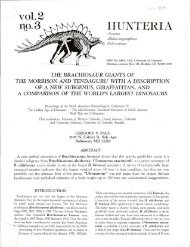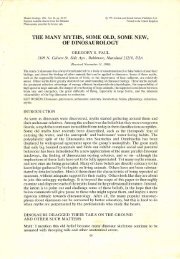Forelimb posture in neoceratopsian dinosaurs - Gregory S. Paul
Forelimb posture in neoceratopsian dinosaurs - Gregory S. Paul
Forelimb posture in neoceratopsian dinosaurs - Gregory S. Paul
Create successful ePaper yourself
Turn your PDF publications into a flip-book with our unique Google optimized e-Paper software.
460 GREGORY S. PAUL AND PER CHRISTIANSEN FORELIMB POSTURES IN NEOCERATOPSIAN DINOSAURS 461<br />
F'GURE 7. Left humeri <strong>in</strong> posterior view, drawn to same length. A, Caman,saurus YPM 1901. B, Apatosaurus CM<br />
3018. C, Toros",,,us MPM VP6841. D, Ctmsmosourus UTEP P.37.7.006. E, Leptoceratops AMNH 5205. F, Rh<strong>in</strong>oceros. G,<br />
Eou us. Proximomed ial lesser tubercle is black; short l<strong>in</strong>es <strong>in</strong>dicate deltopectoral crests.<br />
(1997)argued that the prom<strong>in</strong>ent lesser tubercle<br />
of ceratopsids (Fig. 7C-E), which is usually<br />
greatly reduced <strong>in</strong> mammals (Fig. 7F,G)<br />
would <strong>in</strong>terfere with the ribs if the humerus<br />
moved <strong>in</strong> a near-parasagittal plane. However,<br />
this process is often fairly well developed <strong>in</strong><br />
columnar-limbed sauropods, which often<br />
have a narrow gauge (Fig. 7A,B) (<strong>Paul</strong> 1987).<br />
With the scapulocoracoid properly articulated<br />
there is also a free space medial to the proximal<br />
part of the humerus (Adams 1991; Ford<br />
1997). Additionally, there is little conflict between<br />
a prom<strong>in</strong>ent lesser tubercle and a parasagittal<br />
gait <strong>in</strong> d<strong>in</strong>osaurs, as the glenoid was<br />
anterior to the ribs, as noted above.<br />
As the humerus retracted and the caput articulated<br />
<strong>in</strong>creas<strong>in</strong>gly with the more laterally<br />
oriented coracoidal part of the glenoid. the<br />
humerus may have swung slightly more posterolaterally,<br />
help<strong>in</strong>g to clear the capacious<br />
gut. The more lateral orientation of the anterior<br />
glenoid surface suggests that it may have<br />
been possible to adopt a secondary, wider<br />
forelimb gauge, when the humerus was held<br />
almost horizontally. This could have been useful<br />
under special circumstances, such as graz<strong>in</strong>g,<br />
dr<strong>in</strong>k<strong>in</strong>g, or static <strong>in</strong>terspecific agonistic<br />
behavior.<br />
Another feature of forelimb morphology<br />
that some have argued supports a Wide-gauge<br />
forelimb <strong>posture</strong> is the extremely well developed<br />
deltopectoral crest <strong>in</strong> ceratopsids, particularly<br />
<strong>in</strong> the large chasmosaur<strong>in</strong>es. Russell<br />
(1935),Johnson and Ostrom (1995), and Dodson<br />
(1996) suggested that the associated musculature<br />
was similar to that of sprawl<strong>in</strong>g reptiles,<br />
but perissodactyls also have well-developed<br />
deltopectoral crests (Fig. 7F,G)(Garrbaryan<br />
1974). Dodson (personal communication<br />
1999) suggested that deltopectoral crest morphology<br />
<strong>in</strong> ceratopsians differs markedly<br />
from that of large mammals, <strong>in</strong>dicat<strong>in</strong>g different<br />
axes of humeral rotation. Rh<strong>in</strong>os, however,<br />
like ceratopsians, have large deltopectoral<br />
crests, virtually at right angles to the long<br />
axis of the bone, and they are ma<strong>in</strong>ly rugose<br />
on the proximolateral sides. Overall they<br />
show great resemblance to 'the deltopectoral<br />
crests of ceratopsids.<br />
The slight differences from extant rh<strong>in</strong>os <strong>in</strong><br />
projection of the crest relative to the long axes<br />
of the humeri and the humeral heads could<br />
suggest that ceratopsid humeri were turned<br />
slightly more outward than are the humeri of<br />
large mammals (e.g..Hatcher et al. 1907:Plate.<br />
XLIXB).Deltopectoral crest morphology does<br />
not <strong>in</strong>dicate major differences <strong>in</strong> the axes of<br />
rotation of the humerus between ceratopsians<br />
and large mammals. Prom<strong>in</strong>ent deltopectoral<br />
crests among quadrupedal d<strong>in</strong>osaurs are also<br />
found <strong>in</strong> the Ankylosauria and Stegosauri a,<br />
and <strong>in</strong> the columnar-limbed Sauropoda.<br />
There has been virtually unanimous agreement<br />
that ceratopsian forelimbs were flexed<br />
(Gilmore 1905; Sternberg 1927; Tait and<br />
Brown 1928;Osborn 1933;Brown and Schlaik-<br />
jer 1940; Erickson 1966; Bakker 1971, 1986,<br />
1987; Russell 1977; <strong>Paul</strong> 1987; Tereshchenko<br />
1994; Johnson and Ostrom 1995; Ford 1997).<br />
This orientation is easily recognized because<br />
the humeral caput extends much onto the caudal<br />
side of the humerus and the distal condyles<br />
face anteriorly, thus undoubtedly caus<strong>in</strong>g<br />
substantial elbow flexure. It is the plane of<br />
flexion that is <strong>in</strong> dispute. The distal condyles,<br />
however, do not face ventrally as <strong>in</strong> sprawl<strong>in</strong>g<br />
reptiles (see also Ford 1997). Both the morphology<br />
of the glenoid and the lateromedially<br />
rectangular humeral caput strongly suggest<br />
that this flexion was primarily <strong>in</strong> the anteroposterior,<br />
not the transverse, plane. In fact, the<br />
morphology of the humeral caput makes it<br />
doubtful that ceratopsians would have been<br />
able to protract the humerus past vertical. In<br />
this respect they resemble large ungulates and<br />
rh<strong>in</strong>os and differ from elephants (Fig. 5A-D).<br />
In various reconstructions with sprawl<strong>in</strong>g<br />
forelimbs (Gilmore 1905; Sternberg 1927; Osborn<br />
1933; Erickson 1966; Johnson and Ostrom<br />
1995)the radius and ulna are straight. It<br />
is more likely, however, that the radius and<br />
ulna crossed over (Fig. 6D), albeit probably<br />
not markedly (see Carpenter 1982;<strong>Paul</strong> 1987;<br />
Carpenter et al. 1994; Ford 1997). A straight<br />
radius also makes parasagittal mount<strong>in</strong>g of<br />
the forelimbs difficult, as the distal articulat<strong>in</strong>g<br />
facet then appears disarticulated from the<br />
proximal carpal; however, this problem largely<br />
disappears once the radius crosses the ulna<br />
for support of the lateral humeral condyle.<br />
Thus articulated, the proximal radial articulat<strong>in</strong>g<br />
surface also fits properly <strong>in</strong>to the radial<br />
fossa anteroproximally on the ulna (see Ford<br />
1997).<br />
Ceratopsian trackways are <strong>in</strong>compatible<br />
with wide-gauge forelimbs on an additional<br />
po<strong>in</strong>t besides the width of the manual pr<strong>in</strong>ts<br />
compared with the width between the glenoids,<br />
as described above. The manus impr<strong>in</strong>ts<br />
face anterolaterally (Figs. 2A, 6D), a feature<br />
common <strong>in</strong> quadrupedal d<strong>in</strong>osaur trackways<br />
(e.g., Carpenter 1982; <strong>Paul</strong> 1987; Currie<br />
1993; Thulborn 1993; dos Santos et al. 1994;<br />
Lockley and Barnes 1994;Lockley et al. 1994).<br />
Carpenter (1982),<strong>Paul</strong> (1987),and Ford (1997)<br />
all noted, that if the manus is rotated laterally<br />
the elbow could not also be directed strongly<br />
laterally, as this would rotate the manus medially,<br />
especially dur<strong>in</strong>g protraction (see, e.g.,<br />
Gilmore 1905: Plate 1; Lull 1933: Plates IlIA,<br />
XIVB,XVII;and illustrations <strong>in</strong> Dodson 1996:<br />
P: 275, and <strong>in</strong> Czerkas and Czerkas 1990: p.<br />
212]).<br />
As a result of the most likely orientation of<br />
the glenOid and the orientation of the footpr<strong>in</strong>t<br />
impressions <strong>in</strong> trackways, the elbow is bowed<br />
slightly laterally (contra the perfectly parasagittal<br />
forelimbs restored by Tereshchenko<br />
[1994J),the radius and ulna slope ventromedially<br />
about 15-20°, and the distal end of the<br />
radius is beveled to form a proper articulation<br />
with the carpus (Fig. 6D). In most large extant<br />
mammals the elbows are also bowed slightly<br />
laterally and the manus impr<strong>in</strong>ts almost touch<br />
the midl<strong>in</strong>e, especially <strong>in</strong> the long-limbed elephants.<br />
Manus gauge is usually the same as,<br />
or slightly less than, pedal gauge, hence clearly<br />
narrower than was the case <strong>in</strong> ceratopsids<br />
(Fig. 2B) (Bird 1987; Lockley and Hunt 1995).<br />
Extant wildebeest, however, also place the<br />
manus impressions lateral to the pedal impressions<br />
(Fig. 2C).<br />
The fact that most d<strong>in</strong>osaurs are h<strong>in</strong>dlimb<br />
dom<strong>in</strong>ant and most mammals forelimb dom<strong>in</strong>ant<br />
(e.g.,Alexander 1985,1989;Christiansen<br />
1997;Christiansen and <strong>Paul</strong> <strong>in</strong> press) may also<br />
affect this comparison, although it is difficult<br />
to assess to what extent. Exact forelimb <strong>posture</strong><br />
and placement of the manus may have<br />
varied among ceratopsians, although the similarity<br />
<strong>in</strong> jo<strong>in</strong>t orientation suggests that variation<br />
was m<strong>in</strong>or.<br />
H<strong>in</strong>dlimbs.-It is almost universally agreed<br />
that the h<strong>in</strong>dlirnbs of ceratopsians worked <strong>in</strong><br />
a near-parasagittal manner (Gilmore 1905,<br />
1919; Sternberg 1927; Osborn 1933; Russell<br />
1935; Brown and SchIaikjer 1940; Erickson<br />
1966;Bakker 1971,1986,1987; <strong>Paul</strong> 1987, 1991;<br />
Johnson and Ostrom 1995; Lockley and Hunt<br />
1995; Dodson 1996; Dodsorr and Farlow 1997;<br />
Ford 1997). This <strong>in</strong> accord with the medially<br />
directed femoral caput, the open acetabulum,<br />
the morphology of the knee, and the hemicy-<br />
I<strong>in</strong>drical meso tarsal ankle. Trackways, which<br />
show the h<strong>in</strong>dfeet touch<strong>in</strong>g the midl<strong>in</strong>e (Figs.<br />
IB,C,E and 2A; Dodson and Farlow 1997:Fig.<br />
4), support this view.<br />
As described above, the ceratopsian dorsal









